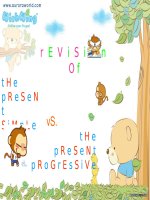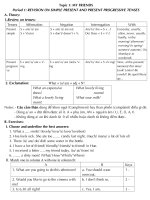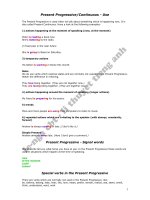Revision ò Present Simple and Present Progressive
Bạn đang xem bản rút gọn của tài liệu. Xem và tải ngay bản đầy đủ của tài liệu tại đây (334.17 KB, 7 trang )
r E V i S i O n
O f
t H e
p R e S e N
t
S i M p L e
t H e
p R e S e N t
p R o G r E s S i V e
vS.
1. fOrM [ present simple ]
S + V
( s / es )
Or S +
am/ is/ are + …
S + don’t / doesn’t + V
inf
Or S +
am/ is/ are + not …
NEGATIVE
AFFIRMATIVE
INTEROGATIVE
Do / Does + S + V
inf
… ? Or
Am/ Is/ Are + S + ... ?
Form [ present progressive
Affirmative
Negative
Interrogative
S + am/ is /are + V-ing
…
S + am/ is/ are + not +
V-ing…
Am/ Is/ Are + S + V-
ing…?
Usages
Repeated Actions: use the Simple Present to express
the idea that an action is repeated or usual. The action
can be a habit, a hobby, a daily event, a scheduled event
or something that often happens. It can also be
something a person often forgets or usually does not do.
Examples: I play tennis.
Facts or Generalizations: the Simple Present can also
indicate the speaker believes that a fact was true before,
is true now, and will be true in the future. It is not
important if the speaker is correct about the fact. It is
also used to make generalizations about people or
things.
Examples: Cats like milk.
Scheduled Events in the Near Future: speakers
occasionally use Simple Present to talk about scheduled
events in the near future. This is most commonly done
when talking about public transportation, but it can be
used with other scheduled events as well.
Examples: The train leaves tonight at 6 PM.
Now (Non-Continuous Verbs): speakers sometimes
use the Simple Present to express the idea that an action
is happening or is not happening now. This can only be
done with Non-Continuous Verbs and certain
Mixed Verbs.
Examples: I am here now.
Usages
Now: use the Present Progressive with Normal Verbs to
express the idea that something is happening now, at
this very moment. It can also be used to show that
something is not happening now.
Examples: You are learning English now.
Longer Actions in Progress Now : in English, "now"
can mean: this second, today, this month, this year, this
century, and so on. Sometimes, we use the Present
Continuous to say that we are in the process of doing a
longer action which is in progress; however, we might
not be doing it at this exact second.
Examples: I am studying to become a doctor.
Near Future: Sometimes, speakers use the Present
Progressive to indicate that something will or will not
happen in the near future.
Examples: I am meeting some friends after school.
Repetition and Irritation with "Always“: the Present
Progressive with words such as "always" or "constantly"
expresses the idea that something irritating or shocking
often happens. Notice that the meaning is like
Simple Present, but with negative emotion. Remember
to put the words "always" or "constantly" between "be"
and "verb + ing."
Examples: She is always coming to class late.









